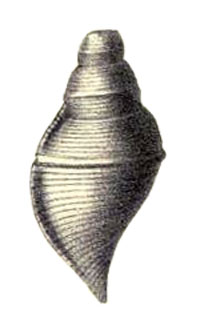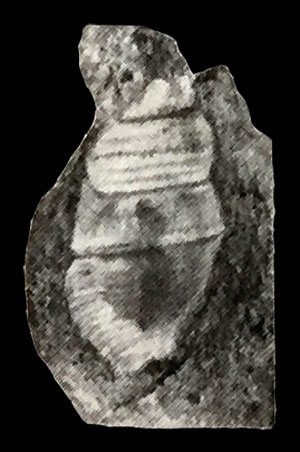|
edit SideBar
|
Species / Anchura Carinifera
Stromboidea
might belong to Teneposita
Original Description of Anchura carinifera by Gabb, 1869, p. 166:
- "I propose this name for a minute shell, of which I have but a single rather imperfect cast. It is short, robust fusiform, the whorls rounded, the body whorl tapering gradually in advance, instead of ending in a slender canal, as in the typical Anchuras. The lower whorls carry a single prominent rib on the middle, and the margin of the mouth is broken where (if it is an Anchura) the lip process should take its rise; the whole surface is ornamented by numerous revolving striae, visible both on the shell and, to a less degree, on the cast, becoming strongly marked on the inner margin of the outer lip."
- "Length of the fragment, less two or three volutions of the apex, .32 inch. From the Martinez Group, Martinez. I have referred this little shell to the genus Anchura, with considerable hesitation, because I have no proof that it possessed the expanded lip, and because the anterior canal, which in all the known species is slender, and more or less produced, is, in this case, short and robust. Further specimens will be necessary before its true generic relations can be definitely settled."
 Anchura carinifera Gabb, 1869, pl. 28, fig. 46
History and Synonymy
1927
Anchura carinifera in Stewart, 1927, pl. 32, fig. 6
1930
Stewart, 1930, p. 14:
- "The horizon of "Cardita" veneriformis as well as that of "Anchura" carinifera is doubtful. A specimen, now with the holotype of "Cardita" veneriformis and probably conspecific with it, is in a coarse, dark gray, limy sandstone, having some black angular fragments. It may well be Cretaceous, but the rock which is not fresh has a greenish tint and fragments of small shells scattered through it. Except the holotype of "Anchura" carinifera, which is preserved in apparently similar rock, none of the other specimens from Martinez has a similar matrix. However, Dickerson has identified specimens occuring with Cucullaea mathewsonii as Cardita veneriformis and, should his determination prove to be correct, there would be no doubt that this species should be referred to the Martinez horizon in the Lower Tertiary - Paleocene of this paper."
1958
Comment in Anderson F.M., 1958 :
- "The Cretaceous age of this species has been suggested by both Stanton (1896), and by Stewart (1926), and there is no reason for altering it. The species was not included in Merriam’s list of type species in the Museum of Paleontology, University of California (1895), although Stewart found the holotype there."
1996
Elder & Saul, 1996, p. 381:
- "Several additional Late Cretaceous Anchura species have been documented from the Pacific Slope. Anderson (1958) listed four species, of which only A. falciformis is discussed herein. None of the other three is a typical Anchura; two, "Anchura" angulata (Gabb, 1864) and "Anchura" biangulata Anderson, 1938, are probably of Albian and Cenomanian age, and "A." carinifera Gabb, 1869, may be of early Tertiary age. "Anchura" carinifera, based on a very small specimen, is comparable to Teneposita Loch, 1989, in size, but the spire has indications of spiral sculpture only and lacks the arcuate axial ribbing of Teneposita and juvenile Anchura."
References
|


